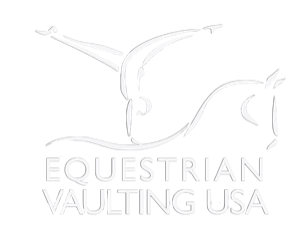The History of Vaulting
Ancient Sport Traced Back to Roman Times
Vaulting enjoys an ancient heritage and can probably be described as one of the oldest known forms of equestrian sport. Often described as “gymnastics performed on horseback,” vaulting’s origins can be traced back to Roman games that included acrobatic displays performed on cantering horses.
Tracing history through the Middle Ages and the Renaissance, many references to vaulting are made, and it was during this time that the practice of “La Voltige” (drill riding and agility exercises performed on horseback by knights and noblemen) gave the sport its present name. Modern vaulting was developed in postwar Germany as a means to introduce children to equestrian sport, and it remains a popular training and competitive endeavor all across Europe. Conversely, modern competitive vaulting is relatively new to the United States. Vaulting did not make its way to the U.S. until the late 1950s, and the first official competition did not take place until 1969.
Since that time, vaulting has experienced significant growth and expansion and is enjoyed by equestrian enthusiasts of all ages. All vaulting routines – team, individual, and freestyle – are performed on the back of a cantering horse traveling in a circle and attached to a longe line. Competitors are judged on their ability to smoothly execute compulsory movements demonstrating strength, flexibility and balance. Vaulters make sure to face all four directions and cover all parts of the horse from neck to croup during their routines. They are also evaluated on the technical difficulty and artistic expression associated with freestyle routines.
Additionally, a portion of every overall score is secured by considering the horse’s quality and consistency of gait. Vaulting offers enthusiasts the opportunity to develop coordination, balance, strength, and creativity while working harmoniously with both fellow teammates and the horse itself.
The History of Equestrian Vaulting USA
The non-profit American Vaulting Association was founded in 1968 by Elizabeth Searle and J. Ashton Moore to build and promote equestrian vaulting in the United States. It became Equestrian Vaulting USA in 2022. Today, there are more than 141 EVUSA vaulting clubs and affiliates in states from Hawaii to Massachusetts and Alaska to Florida. EVUSA has more than 1,200 members in the United States and Canada.

2000 A Team National Champions F.A.C.E. Vaulters compete in Livermore, CA

Mt. Eden’s Mike Sisul, Shannon Wilcox and Ellen Markowski on Alto, circa 1981.
Photo: EVUSA Archives

Team Kennolyn on Pipsqueak in 1969, lunged by founder Elizabeth Searle. Photo: EVUSA Archives

Hidden Hills Vaulters Steve Sullivan basing Kellyn Marks on Tom in 1981.
Photo: EVUSA Archives

Hidden Hills Vaulter John Hutchings on Tom in 1971, lunged by Brian Sabo.
Photo: EVUSA Archives

Kim Gussenhoven, Leprechaun Vaulters, performs a back handspring, circa 1977.
Photo: EVUSA Archives

30-year EVUSA members at the Gala Event, 2004: Nancy Stevens-Brown, Naomi Takemoto, Adrienne Stang, Elizabeth Searle, Joyce Gussenhoven, Hope Scherf, Jeff Moore, Jane Garrod.
Photo: Patti Reschar

Mt. Eden Vaulting Club’s 1982 National Championship A Team. Mike Sisul and Emma Drinker base Shannon Wilcox on Alto, in the double deadman. Jan Garrod lunges.
Photo: EVUSA Archives

1986 National Champion Sonia Hansen, Rainbow Vaulters, on Regenbogen.
Photo: EVUSA Archives

2003/2004 National Gold Men’s Champion Blake Dahlgren.
Photo: Eric Jewett

2003 National A Team Champions Mt. Eden Vaulting Club Sun Team on Jack.
Photo: Eric Jewett

Two-time National Gold Women’s Champion Pam Geisler performs her gold freestyle.
Photo: Eric Jewett
